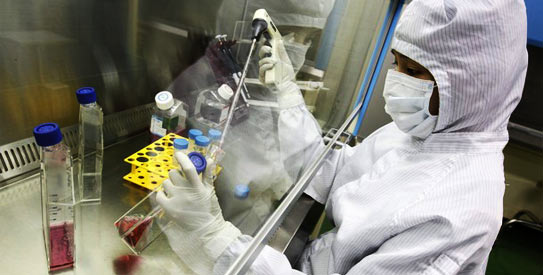British scientists have made the first human embryonic stem cells of a grade high enough for use in patients and deposited in a bank of stem cells for public development in human trials by pharmaceutical companies and researchers by 2014.
A team from King's College London said Monday they had submitted two clinical quality stem cell lines in the UK Stem Cell Bank (UKSBC), which will test and validate them before offering them to researchers.
This could accelerate the path to new stem cell treatments for conditions such as blindness, serious injury or heart disease.
"This first batch of cells is the culmination of nearly 10 years of research. This is an important step, "said Peter Braude, who led the team of the King.
The cells are the first to be grown completely free of animal products, known as "xeno-free," and developed specifically for clinical quality and public use.
The hope is that the cells will be grown and processed by the bank stocks to feed the cells to human trials and, in addition, treatment of patients.
The cells have the potential to become the "gold standard" lines of development of new therapies based on stem cells for use in trials in patients with regenerative medicine, Braude told reporters at a briefing.
It may be several years before the treatments are fully developed and licensed, but the cells could be used in human trials of potential therapies by 2014, the team said.
Stem cells are master cells of the body, the source of all other cells. Scientists say they could transform medicine, providing treatment against blindness, spinal cord and other injuries, as well as generating cells of damaged organs.
Human Embryonic Stem (HES) cells can be grown in the laboratory indefinitely while retaining their ability to develop into different specialized cell types such as nerve or heart muscle cells, which can then be used in clinical trials.
British bank of stem cells has already more than 90 lines of level of stem cell research for use in laboratory studies, but does not yet have clinical category xeno-free lines for use in human trials.
"In the future, patients hoping for the benefit of regenerative medicine for serious medical conditions caused by illness, injury and aging can expect progress on improving the remedies and improvement hES therapy cell, "said Dusko Ilic, professor of stem cell science to the King.
Some companies, like Pfizer and Advanced Cell Technology, already conduct or are about to start human trials using hES cells - which are harvested from embryos - to test their potential to repair spinal cord and eye disorders such as macular degeneration.
But the lines of hES cells for these first tests have been reclassified to "research grade" to "clinical grade" for specific short-term clinical studies in the areas of selected diseases.
Braude said it is not considered appropriate for the future of cell therapy because of the cost of further testing and rehabilitation, and potential risks.
"While it might be reasonable to additional risks for these first pioneering studies, it is not reasonable to accept these risks to the long-term future," he said. "Therefore, the highest standard of xeno-free lines are urgently needed."
Team Braude cells were grown from frozen embryos donated by patients who had in vitro fertilization (IVF) and did not want to use their remaining embryos stored. The embryos would otherwise be discarded, Braude said.
Glyn Stacey, director of the UKSCB, said the front lines of clinical grade is an "important resource" and a first step towards the objective of the bank to provide a range of clinical tests contours in the next three years.
"The testing process is rigorous and not all cell lines received will be up," he said



Post a Comment